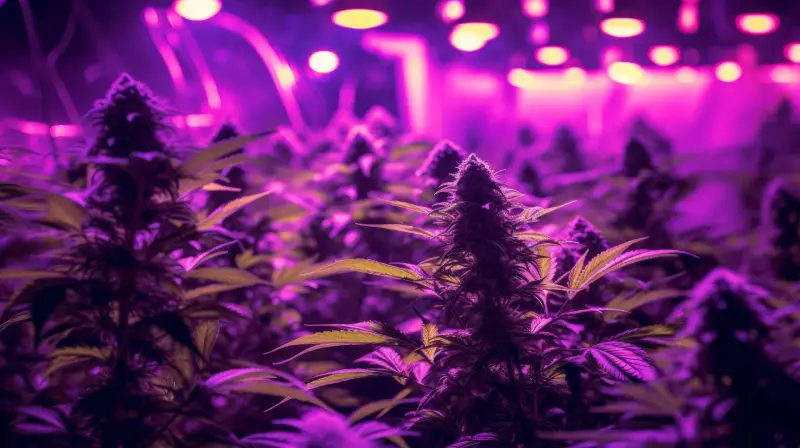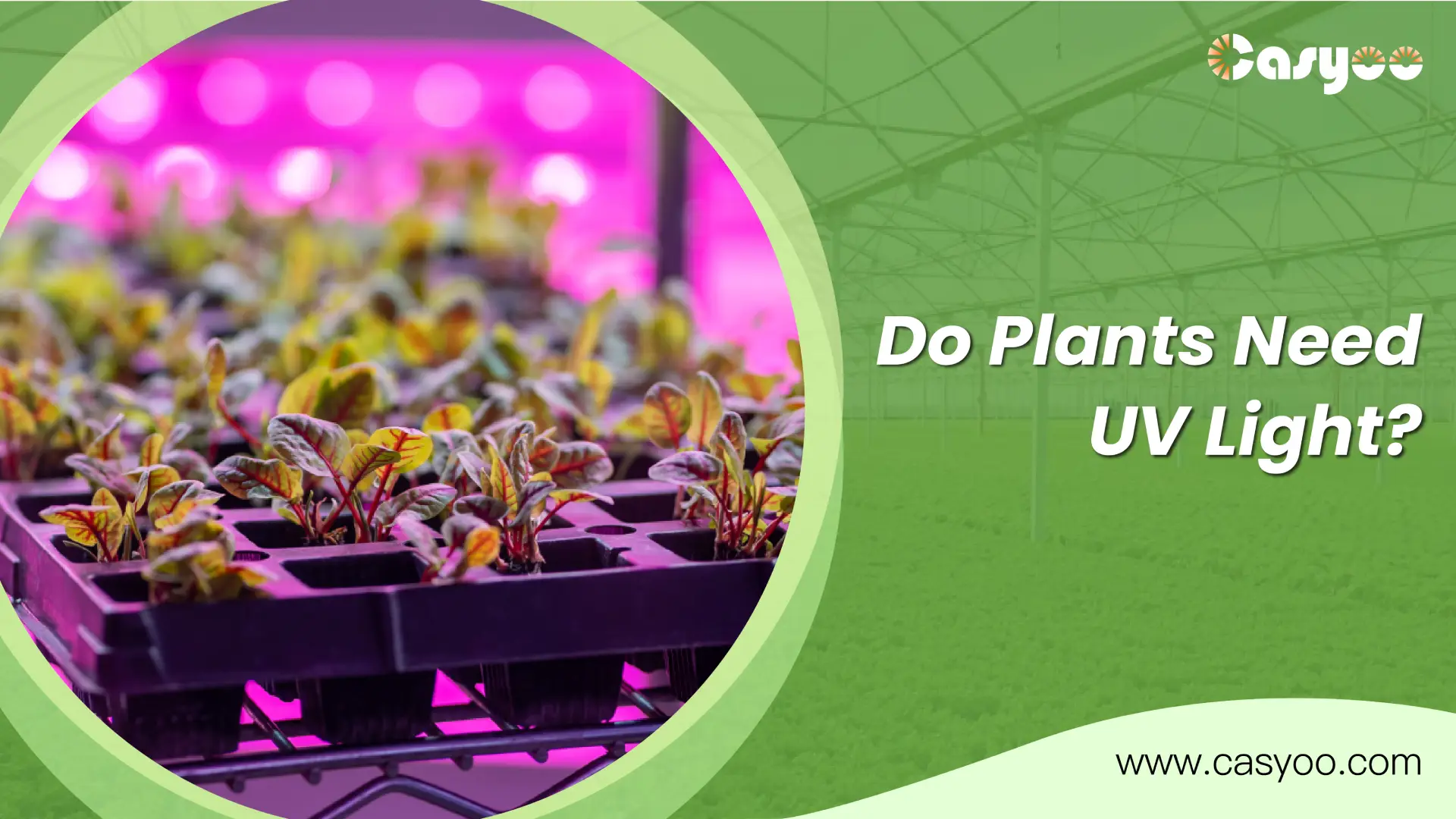We all know that grow lights need to emit specific wavelengths of light to make plants grow. UV light for plants are controversial. Some people claim that using UV light is harmful to plants, while others claim that using UV light brings out the natural flavors and smells of plants.
The truth is, that UV rays can be beneficial to your plants, but only if you know how to use them. Let’s keep reading.
How does UV light affect plants?
UV light features three wavelength ranges denoted as UVA (320–400 nm), UVB (280–320 nm) and UVC (200–280 nm). However, plant responses to UV light vary depending on plant type and wavelength. The main benefits can be boiled down as follows:
Improve flower quality, potency and weight
UV light can enhance the generation of terpenes and flavonoids in plants. Specifically, UVA light is responsible for increasing the flavor and aroma of flowers, making them more appealing. UVA light can also increase plant root mass, promote vegetable branching, and reduce stretching, resulting in closer internodes and heavier harvest weights.
Some studies have proven that UVB light can increase the resins and oils contained in grown plants. As a result, your flowers will be more potent and you can command a higher price as a commercial grower.
Increase resistance to stress and disease
Once exposed to UVB light, plants can produce up to 15 different defense proteins. Additionally, UV rays are capable of destroying harmful microorganisms, especially at wavelengths shorter than 300 nanometers. Not only that, UVB light can also increase plants’ resistance to bacteria, insects and fungi.
Faster germination
UVA light promote seed germination. They enhance plant growth and prepare it for higher light intensities. It reduces the “shock” time of seedlings while expediting germination.
Is UV radiation harmful to plants?
If UV rays are too strong or too close to plants, they can cause damage. For instance, too much UV exposure can cause plants to bleach. Bleaching prevents leaves from absorbing light, causing stunted growth and low yields.
Overexposure to UV rays can also severely damage flavonoids and terpenes. Even if the leaves are not affected, the fruit and buds can lose flavor due to too much UV light.
How to use UV light in your growing space?
Do plants need uv light? Although UV light provides certain benefits to plants, photosynthesis primarily relies on the PAR spectrum (400-700nm). Therefore, except for certain specific plants, UV light is not essential for plant growth. In professional plant cultivation—such as cannabis, medicinal plants, and scientific research—growers supplement UV light for short periods in addition to standard PAR spectrum lighting. Below are the optimal UV light intensity and duration for various suitable plants:
|
Plant type |
UV light type |
Intensity (W/m²) |
Daily exposure time (h) |
Effect |
|
Cannabis |
UVA |
2-10 |
8-12 |
Enhances growth activity |
|
UVB |
0.1-0.5 |
1-3 |
improves the aroma, flavor, and medicinal properties |
|
|
Succulents, Cacti |
UVA |
1-10 |
6-12 |
Promotes red pigments and UV resistance |
|
Rosemary, Thyme |
UVB |
0.05-0.3 |
0.5-1 |
Enhances the flavor and medicinal properties |
|
Tomatoes, Peppers |
UVB |
0.05-0.2 |
0.5-1 |
improves fruit quality and nutritional value |
|
Perilla, Red Leaf Lettuce |
UVB |
0.05-0.3 |
1-1.5 |
Promotes pigment accumulation |
What to bear in mind to use UV light for plants
- The light needs of your plant type: Not all plants generate resin, and not all resins are as useful as you might hope. If you are going to use UV light, make sure your plants will actually benefit from it. If possible, you will also want to determine the height, power, and location of the UV light around the plant to safely produce resin.
- Height and Space Constraints: Additionally, you need to place your UV light at the same height as your grow light. Hanging a UV light too close to your plants can cause the plants to fade, so make sure there is enough space to hang the UV light at a safe distance.
- Safety Precautions: Prolonged exposure to UV rays without any safety protection can cause damage to humans and plants. You need to limit the time and intensity of UV light your plants are exposed to, as these excessive UV rays may bleach or burn your plants. If you are exposed to UV rays for an extended period of time, it is recommended to protect yourself by wearing protective glasses and long sleeves.
How to choose the best UV light for plants?
1. Spectrum
Choose a UV light that emits wavelengths effective for plant growth. Specifically, UV-B (280-320 nm) along with UV-A (320-400 nm) provide maximum benefit to plants through their stimulation of phytochemical creation and increased resistance. Avoid UV-C (below 280 nm), as it can damage plant DNA.
2. Intensity
The light intensity should match the plant’s needs. For seedlings, use low-intensity UV light to avoid stress. The development of mature plants benefits from stronger radiation levels that enhance growth and phytochemical production.
3. Light Coverage
Ensure the light covers the entire plant canopy evenly. Moreover, the distance between the light source and the plants should be adjustable to optimize light absorption and prevent overexposure.
4. Customizability
Choose a UV light that comes with adjustable spectrum as well as adjustable intensity capabilities. A customizable system makes it possible to match specific light requirements of plants at different stages because each type requires different light conditions.
5. Safety Features
The light system should include safety features in the form of protective layering and shielding to protect growers from direct UV exposure.
Final thoughts
All in all, UV light, especially UVB light, is very beneficial to plants. Not only does it promote growth, yield and quality, but it also helps improve resistance to pests and diseases. However, it is crucial to use UV rays safely and appropriately to avoid damaging plants. As long as the correct precautions are taken, UV light can be a very useful tool for any plant grower.
Casyoo grow lights have one of the best light spectra for growing plants, with higher levels of beneficial UV rays than the competition. Don’t miss out, contact us now!




